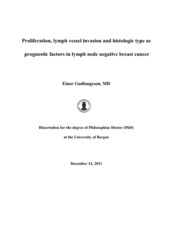| dc.contributor.author | Gudlaugsson, Einar | en_US |
| dc.date.accessioned | 2012-03-12T14:39:05Z | |
| dc.date.available | 2012-03-12T14:39:05Z | |
| dc.date.issued | 2011-12-14 | eng |
| dc.identifier.isbn | 978-82-308-1909-8 | en_US |
| dc.identifier.uri | https://hdl.handle.net/1956/5701 | |
| dc.description.abstract | Breast cancer is a leading cause of cancer mortality among women in the western world, second only to lung cancer. Since the mammography screening program in Norway started in 1995, 70% and more of all new breast cancers diagnosed are small tumors 2cm in diameter without signs of regional or distant metastasis. Not surprisingly, the five year relative survival is very good (87.8%). Their improvement of absolute 10% survival with adjuvant systemic chemotherapy is less substantial than that for lymph node-positive patients. Both 7 the benefits and disadvantages of this 10% survival improvement must be considered when deliberating adjuvant systemic therapy (1, 2) and prognostic/predictive features are important in these decisions. Often, a combination of features is used in the decision making process for adjuvant systemic therapy, where tumour diameter, oestrogen receptor, grade and also age play a major role (3, 4). These guidelines identify 80% or more of all node-negative patients as high risk, although only ~15% of these patients die from metastatic disease without adjuvant treatment. This means that 65% of these patients are over-treated. On a world-wide basis, a more sensitive and specific prognosticator could therefore prevent enormous unnecessary suffering. | en_US |
| dc.language.iso | eng | eng |
| dc.publisher | The University of Bergen | eng |
| dc.relation.haspart | Paper I: Baak JP, Gudlaugsson E, Skaland I, Guo LH, Klos J, Lende TH, Søiland H, Janssen EA, Zur Hausen A. Proliferation is the strongest prognosticator in node-negative breast cancer: significance, error sources, alternatives and comparison with molecular prognostic markers. Breast Cancer Research and Treatment 115(2): 241-54, May 2009. Full text not available in BORA due to publisher restrictions. The article is available at: <a href="http://dx.doi.org/10.1007/s10549-008-0126-y" target="blank"> http://dx.doi.org/10.1007/s10549-008-0126-y</a> | en_US |
| dc.relation.haspart | Paper II: Lende TH, Janssen EAM, Gudlaugsson E, Voorhorst FJ, Smaaland R, van Diest P, Søiland H, Baak JPA. In patients younger than age 55 years with lymph nodenegative breast cancer, proliferation by mitotic activity index is prognostically superior to Adjuvant! Journal of Clinical Oncology 29(7) :852-858, December 2010. Full text not available in BORA due to publisher restrictions. The article is available at: <a href="http://dx.doi.org/10.1200/JCO.2009.25.0407" target="blank"> http://dx.doi.org/10.1200/JCO.2009.25.0407</a> | en_US |
| dc.relation.haspart | Paper III: Gudlaugsson E, Skaland I, Janssen EA, van Diest PJ, Voorhorst FJ, Kjellevold K, zur Hausen A, Baak JP. Prospective multicenter comparison of proliferation and other prognostic factors in lymph node negative lobular invasive breast cancer. Breast Cancer Research and Treatment 121(1): 35-40, May 2010. Full text not available in BORA due to publisher restrictions. The article is available at: <a href="http://dx.doi.org/10.1007/s10549-009-0442-x" target="blank"> http://dx.doi.org/10.1007/s10549-009-0442-x</a> | en_US |
| dc.relation.haspart | Paper IV: Gudlaugsson E, Skaland I, Undersrud E, Janssen EA, Søiland H, Baak JP. D2-40/p63 defined lymph vessel invasion has additional prognostic value in highly proliferating operable node negative breast cancer patients. Modern Pathology 24(4) :502-11, April 2011. Full text not available in BORA due to publisher restrictions. The article is available at: <a href="http://dx.doi.org/10.1038/modpathol.2010.199" target="blank"> http://dx.doi.org/10.1038/modpathol.2010.199</a> | en_US |
| dc.relation.haspart | Paper V: Gudlaugsson, Skaland I, Janssen EAM, Feng W, Shao Z, Malpica A and Baak J. Automation of measurement of Ki67 proliferation is essential for optimal reproducibility and accurate prognosis prediction in T1-2N0M0 breast cancer. Full text not available in BORA. | en_US |
| dc.relation.haspart | Paper VI: Gudlaugsson, Skaland I, Janssen EAM, Feng W, Shao Z, Malpica A and Baak J. Multivariate comparison of the prognostic value of the proliferation markers Mitotic Activity Index, PhosphoHistone-H3, Ki67, steroid receptors, HER2, basal cell type and classical prognostic factors in T1-2N0M0 breast cancer. Full text not available in BORA. | en_US |
| dc.title | Proliferation, lymph vessel invasion and histologic type as prognostic factors in lymph node negative breast cancer | en_US |
| dc.type | Doctoral thesis | |
| dc.rights.holder | Copyright the author. All rights reserved | |
| dc.subject.nsi | VDP::Medical disciplines: 700::Clinical medical disciplines: 750::Oncology: 762 | eng |
